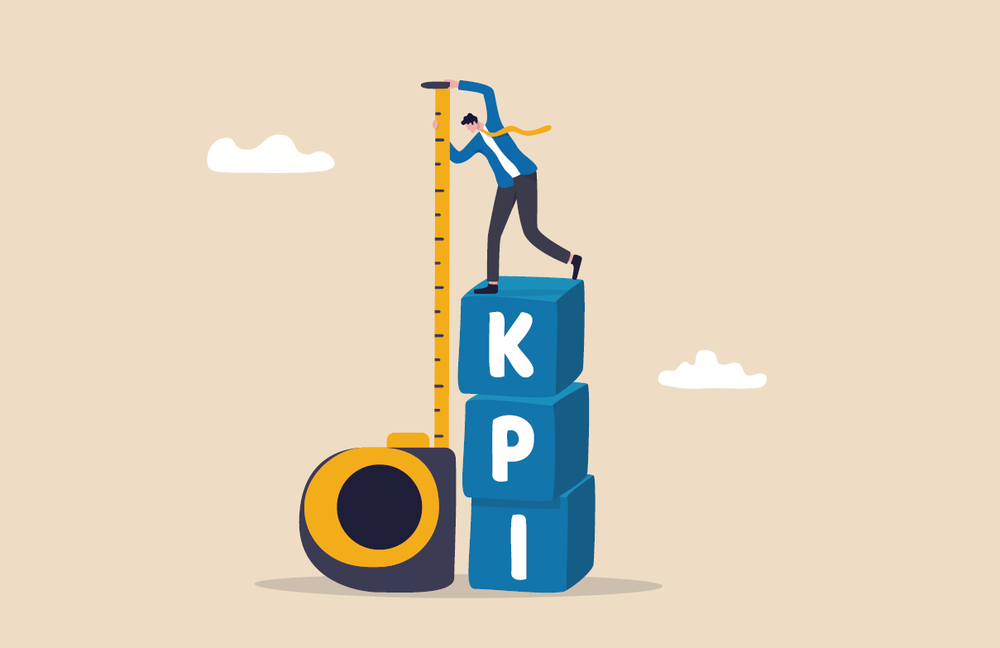
November 01, 2023
Setting Website KPIs that Reflect Your Organization's Goals

Navigating the digital world can sometimes feel like a maze. However, there's a guiding tool that can help you find your way - Key Performance Indicators, also known as KPIs. These straightforward measures, often shown as data and percentages, act as crucial guideposts. They lead us towards achieving our organization’s goals. But how can you set KPIs for your website that truly mirror your organization's purpose?
In simpler terms, management expert Peter Drucker once said, "What gets measured gets managed." This statement is the heart of why we use KPIs. As a key point of contact for your organization's audience, your website needs clear targets to make sure it's doing its job effectively.
To create meaningful KPIs, it's important to look closely at your data and take into account the user experience and their journey. As Lead Content Strategist Amanda de Zayas pointed out in a recent Digital Center of Excellence webinar on KPIs, "It's crucial to focus on what the website or its managers can control. If it's not within your power, don't set yourself up for failure." In short, keep things straightforward and relevant.
Laying the Groundwork
Before diving into the intricacies of KPIs, establish a strong foundation. This means having a detailed content plan, understanding your information architecture, defining key user journeys, and organizing information in your taxonomy. But we just dropped a lot of terms. Let’s define a few of them before we go further.
- Key Performance Indicators (KPIs) are measurable metrics used to assess and gauge the success or performance of specific objectives,goals, or initiatives within an organization. They are the quantifiable indicators that help evaluate how well a website or digital platform aligns with an organization’s mission, goals, and user expectations.
- A content plan, often called a content strategy or calendar, is a structured document that outlines what content to create, when to publish it, and how to promote it. It helps ensure content aligns with goals, targets the right audience, and maintains consistency. Content plans include goals, topics, formats, a publishing schedule, and metrics for success.
- A content model. A content model differs from a content plan in that the model defines the structure and relationships of content types and elements within your site. For example, it might define content types such as articles, product pages, or user profiles.
- Information architecture is a structured framework that organizes and categorizes content on websites or digital platforms to enhance user experience and accessibility. It defines how information is grouped, labeled, and navigated, ensuring users can find what they need easily.
- A user journey refers to the path or sequence of interactions and experiences that a user goes through when navigating a website or digital platform. It encompasses the steps users take to achieve their goals or find information, from the initial entry point to the desired outcome.
- Taxonomy is the systematic classification and organization of content or data, categorizing it into logical groups or hierarchies. This structured approach makes it easier for users to locate and understand information, improving navigation and searchability on websites or digital platforms.
So, now that we’re clear on our language, consider asking yourself these core questions:
- Who are your users? Understand your audience's demographics, preferences, and needs.
- What are their objectives? Define what they are trying to accomplish.
- What are their pain points? What are they struggling with?
- How will they discover your solutions? Identify the pathways users take on your website.
- What actions do you want them to take next? Determine the desired outcomes.
- Do you have a detailed content plan in place? Organize and optimize your content.
- Have you defined your key user journeys? Map the critical user paths.
- Have you organized information in your taxonomy? Create a logical structure for your content.
By answering these foundational questions, you can take an inventory of your content, organize and test it, and start formulating a strategy.
Turning Goals into Metrics
Remember, KPIs should be relevant and meaningful to your organization's goals. It's easy to be overwhelmed by the plethora of metrics available, but the focus should always be on those that align with your objectives. It’s a good idea to keep it simple. Two or three impactful metrics might even be enough to start. Don’t overwhelm yourself.
For instance, if you use Siteimprove, you could start with the Digital Certainty Index (DCI) score as a basic KPI. The DCI score provides a comprehensive view of your website's quality, SEO, and accessibility. It's an easy-to-understand metric that can give you an immediate sense of how user-friendly and findable your site is.
To turn your organizational goals into actionable metrics, you really need to define what success looks like for your organization. For instance, if your goal is to increase public engagement, your metrics might be program enrollment and newsletter sign-up rates. The action to track these metrics (the 'trigger') could be form submissions for program enrollment or newsletter sign-ups.
Careful Considerations
Setting KPIs requires careful consideration. As Amanda emphasized in our recent webinar it's not about chasing one number, or even four or five oft-touted "vanity metrics."
Vanity metrics refer to superficial or surface-level data points that may seem impressive but often lack real insight. Metrics like sessions, page views, time spent on a page, or unique visits may appear significant but may not tell the complete story and may not align with your organization’s core goals or user experience.
To make her point, she compared KPI metrics to getting a blood test. One number doesn’t signify your health. Analytics are really not that different. You need to look at several metrics in combination to get context. You need to consider your metrics together to create a picture of what a user is experiencing and how a user is behaving.
An illustrative example is the surge in web traffic during the early days of the COVID-19 pandemic. While increased traffic seemed like a success, it revealed a deeper issue. Users were struggling to access vital information, contact the right authorities, and navigate the system. This highlights the importance of contextualizing metrics within the user's real-world experience.
In the realm of government websites, private sector metrics don't always translate seamlessly. For example, public sector sites typically set a goal to “increase engagement.” Sounds great. But in agency sites, do we really want to increase engagement? Or do we want users to simply find what they want and leave?
Finding Meaning Beyond the Numbers
Use tools. Once you have defined your KPIs, tools like Siteimprove or Google Analytics can be used to track these metrics. These platforms allow you to set goals, choose key metrics to measure, monitor progress, assign responsibility, and decide on actions if the KPIs are not being met.
Get context. As we mentioned earlier, you want to look at these metrics in context rather than in isolation, to get a more accurate and holistic view of your website's performance. For example,if you are tracking drop-off rates, you'll want to look at user journeys, maybe behavior mapping, time on the website, and exit rates all together to determine what you think is going on.
Ask why. It's critical to question the “why” behind each metric. What specific insights are we seeking? What do these metrics reveal about our website's performance and its alignment with our organizational goals?
Definitions vary. It's worth noting that in different analytics programs, metrics can have varying definitions. Sometimes, these definitions can even be customized to suit your specific needs. For example, in the case of bounce rates, what is considered a bounce may vary. This illustrates why using metrics other people tell you are important may fall short. That’s why it’s important to define in detail what you will measure when you set a goal.
Think like a user. A crucial lens through which to view metrics is that of the user. What is the user's journey, and how do they perceive our website? Are there multiple competing calls to action that might confuse or overwhelm them?
Actionable Items
Here are some ways that can help improve your agency's content strategy:
- Start Working on Your Content Model
If you haven't already, start working on your content model.
- Define Content Types: Identify the various types of content your team produces (e.g., articles, videos, infographics).
- Attributes and Fields: Determine the specific attributes and fields associated with each content type, such as title, author, and publication date.
- Relationships: Map out how these content types and attributes relate to each other within the content structure.
- User Journeys: Consider how users interact with and navigate through your content.
Remember that your content model is the foundation for structured content creation, making it easier to set and track KPIs that align with your content goals and user expectations.
-
Align Team Goals
Gather your entire team to align on your organizational goals. Make sure everyone attends,from leadership to content contributors, to ensure everyone is on the same page. -
Translate Organizational Goals to SMART Goals
Take the organizational goals discussed today and translate them into SMART goals.Brainstorm and assign KPIs to these goals for trackability. -
Use Siteimprove
Set up some of the advanced tracking that we mentioned inside Siteimprove, such as KPIs, key metrics, user journeys, funnels, etc. They have a plethora of great tutorials, webinars, and resources to assist you. -
Monitor Your Performance Regularly
Make sure to set benchmarks and monitor your performance regularly. Build a custom dashboard in Siteimprove to include your KPI metrics and schedule it to be delivered to your inbox weekly or monthly.
Next Steps
Embarking on the journey of setting effective KPIs for your government agency website can be challenging, but it's crucial to aligning your site's performance with your organizational objectives. Remember, it's not just about the numbers; it's about efficiently delivering the information and services that Georgians need.

